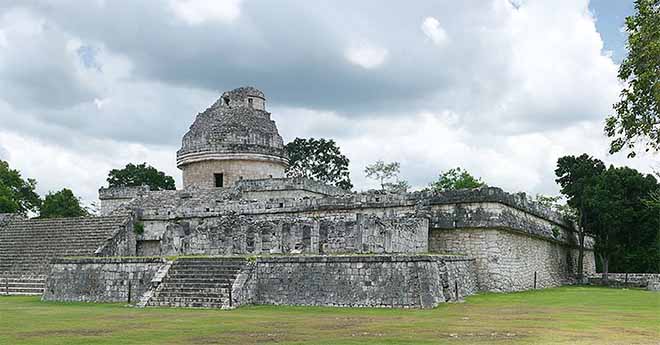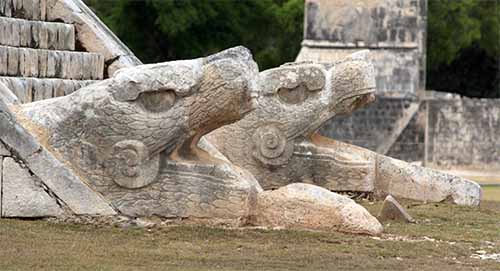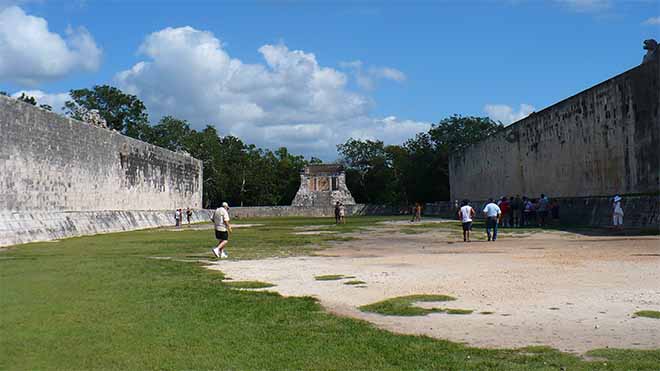Inside The Ruins of Chichen Itza Mexico And It's Observatory
Were Mayan Astronomers ?

The Mayan civilization flourished in the Mexican peninsula of Yucatan, at a time which corresponds, in Europe, to the Middle Ages: immense cities were built in the middle of the tropical forest, rich in marvelous pyramids and magnificent temples. But it is a place which combines religion and astronomy more than others. Covering an area of 3 square kilometers, Chichen Itza Mexico was one of the most important Mayan cities. The site of Chichen Itza includes many fascinating buildings. Among the most mysterious, there is the famous Kukulkan Pyramid (El Castillo), the El Caracol astronomical observatory as well as the famous mayan ball game court, with such singular rules, without forgetting the Sacred Cenote of sacrifices.
Chichen Itza observatory of El Caracol: Mayan astronomy and the origin of the Mayan calendar

El Caracol, which means snail in Spanish, indicates the interior staircase (spiral) of Chichen Itza' old astronomical observatory. Its entries are aligned with the spring equinox while other elements recall astronomical events related to the Moon and the legend of the serpent god, the bearer of knowledge. During the day, the Mayans studied the movement of the Sun, analyzing the shadows cast inside the building while at night, they observed the reflection of the stars in large stone basins filled with water. The Mayans, who were serious observers of the night sky, knew the movements of the Universe, stars and planets; this is how they worked out their mythical calendar. Their scientific knowledge merged with religious beliefs. They seemed to be aware of the fact that our galaxy, the Milky Way, has the shape of a spiral in the center of which is a black hole. Hunab Ku, the god of creation among Mayan religion, is effectively represented in the form of a spiral at the center of which he creates life through powerful explosions. For some, this spiral is precisely an obvious religious metaphor describing the Milky Way.
El Castillo : A tribute to the serpent deity Kukulkan

The main monument of the city of Chichen Itza Mexico is a surprising pyramid, El Castillo, also closely linked to Mayan astronomy: it is from the serpent deity Kukulkan that, according to Mayan mythology, the Maya received knowledge, and it was his return that they expected. The Temple of Kukulkan is constructed in such a way that, on the equinox days, the sun illuminates the grand staircase of the northwest by creating the shadow of what is truly in the shape of a huge snake. It was also designed in such a way that on December 21, 2012, the famous date ending the cycle of the triple Mayan calendar, the northwest edge projected a set of lights on the steps in order to illuminate the head of the snake carved at the base of the staircase. Some saw it as a sign of Kukulkan's return to Chichen Itza.
The Mayan deadly ball game and Chichen Itza court

The city of Chichen Itza Mexico is also home to an impressive court designed for Mayan deadly ball games: 146 meters in length and 36 meters in width, the perimeter of which is surrounded by walls reaching almost 8 meters in height. The Mayan ball game was a very violent but also much appreciated game whose meaning was sacred. The object of the game was to pass the ball through sealed stone rings about 7 meters above the ground; the winning team was the first to hit the target. But in the center of Chichen Itza ball court, a macabre sign represents the decapitation of a ball player; some claim that this was the fate of the losers. A more recent interpretation claims that, on the contrary, it was the captain of the victorious team who had to be beheaded. It was a glory to be sacrificed to the gods: a victory that led to death, a way of being considered a god. But others also think that the whole Mayan ball game would have only consisted of representing, in an elaborate metaphor, the astronomical phenomenon of the precession of the equinoxes: an extremely important knowledge for men obsessed by the movement of the stars and calendars. How is it that the Mayans possessed such highly developed astronomical and architectural knowledge? And most importantly, where did they learn everything they knew ? The mystery remains.
John Lloyd Stephens, the explorer who recounted his discovery of Chichen Itza Mexico in 1841, wrote down in his travel journals a disillusioned response : “Sitting on the edge of the wall, we tried in vain to penetrate the mystery that surrounds us. Who were the people who built these cities? The stranger who is among the ruins of Egyptian cities, even in those of Petra, knows the history of the people to whom these vestiges belonged. But when we asked the Indians, their monotonous response was always the same: “Quien sabe?” - "Who knows ?".









































































































































































































































































































































